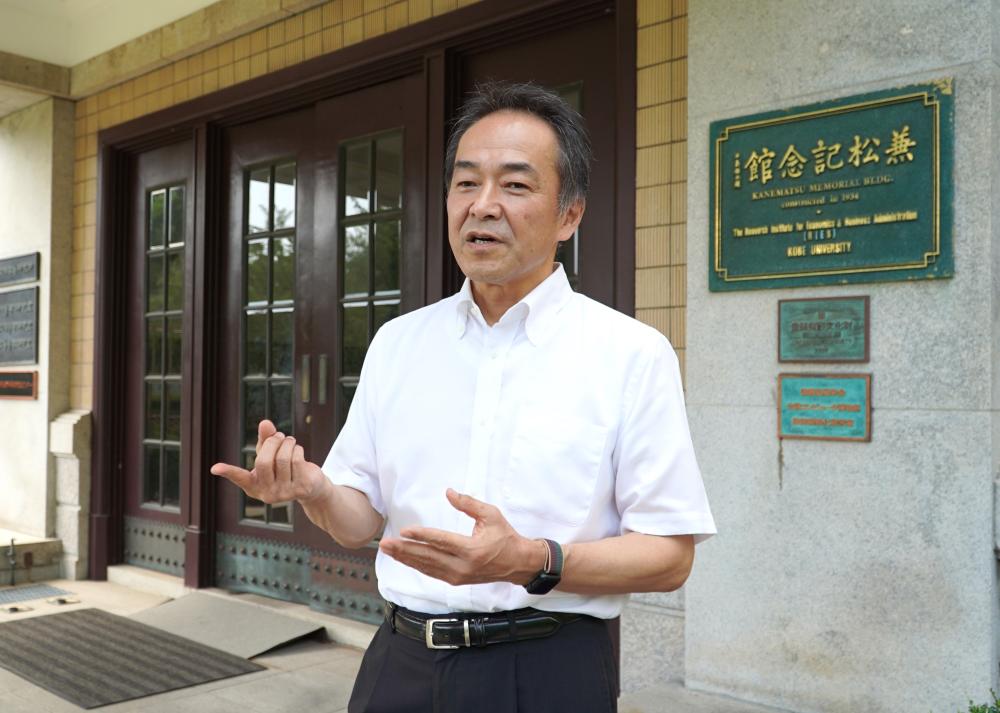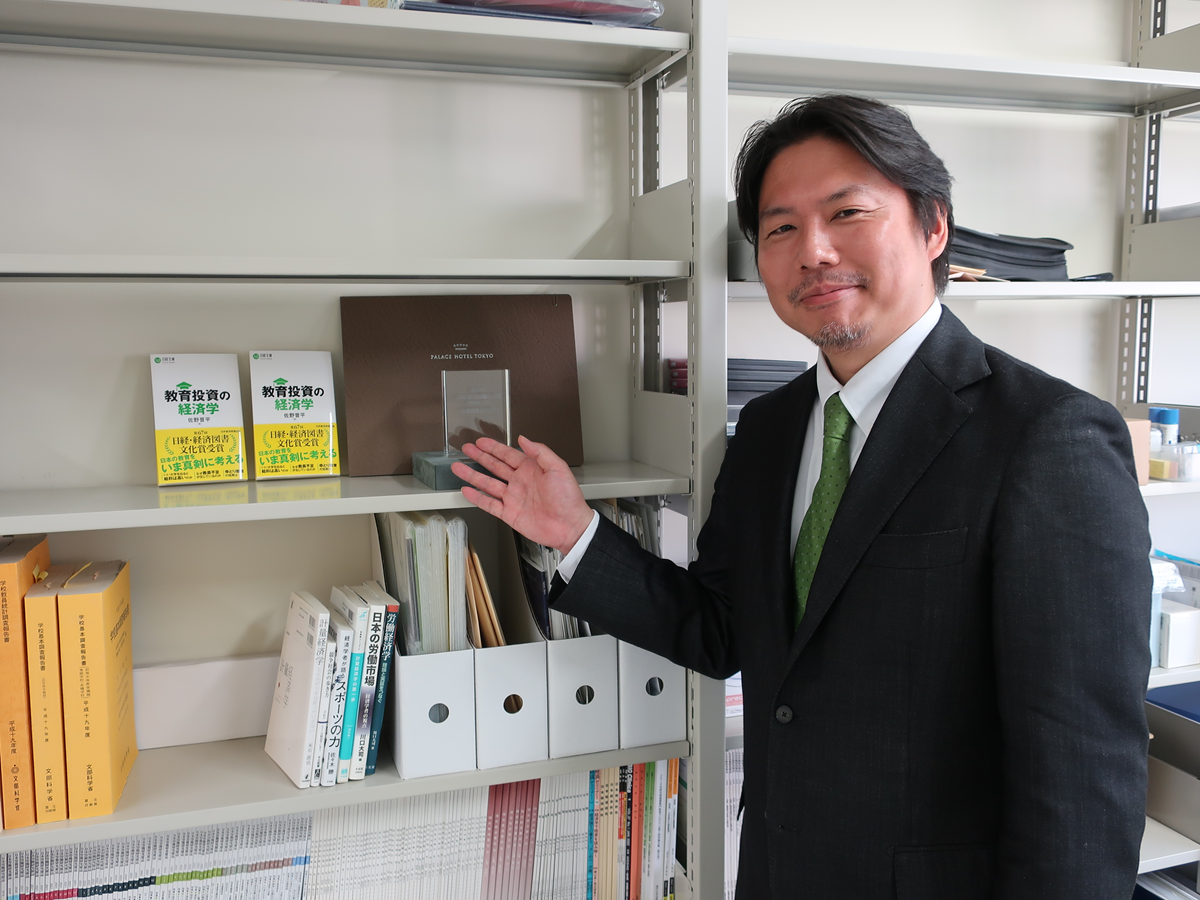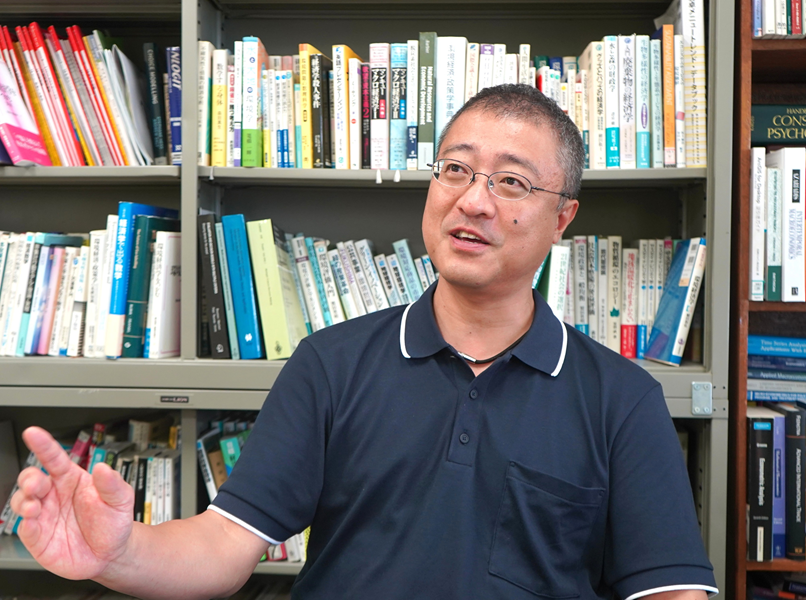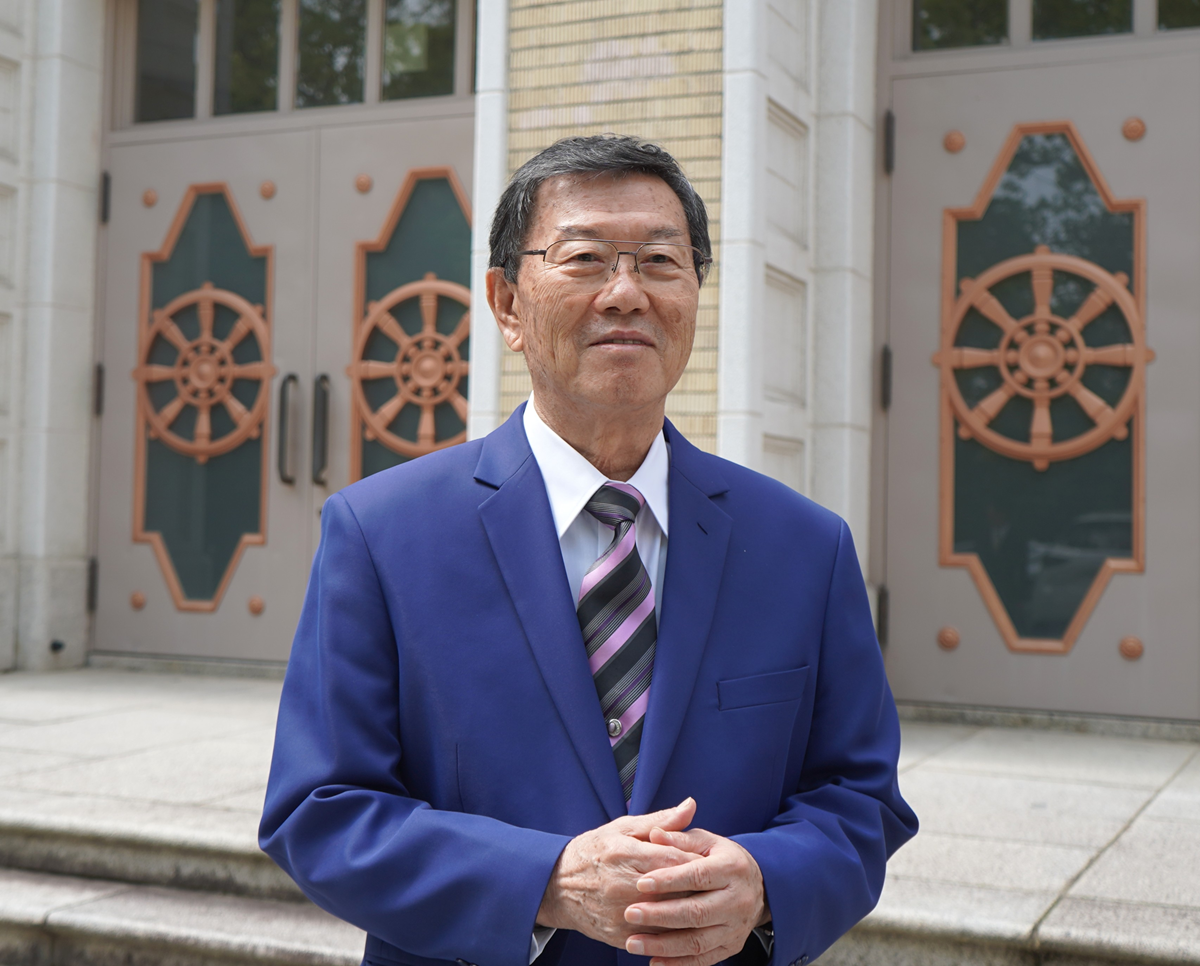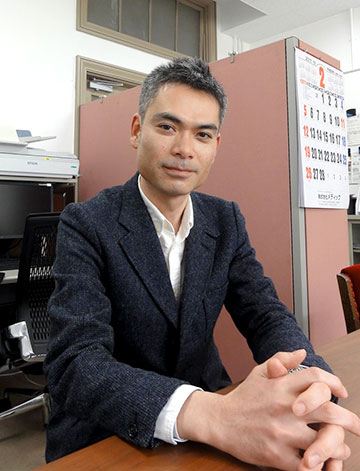
The average wage in Japan has remained low ever since the country’s economic bubble burst in 1991. The gap between Japan and developed countries in the west has widened, while average wages in countries such as Singapore and South Korea have overtaken Japan. Why does it seem like only Japan is losing? How are working styles changing for young people, including university students who will soon be entering employment?
We ask Professor YUGAMI Kazufumi (Graduate School of Economics) who specializes in Japan’s labor market and labor policies.
Labor shortages in essential jobs where pay raises are unlikely
Wages in the west and neighboring Asian countries like South Korea have been gradually rising. Why have wages in Japan remained low?
Professor Yugami:
I would like to reference Japanese economist GENDA Yuji’s book ‘Why are wages not increasing in spite of the labor shortage?’ (‘人手不足なのになぜ賃金が上がらないのか’ published by Keio University Press in 2017). In the book, researchers from many different fields approach this issue from a variety of angles.
From textbook economics perspective, wages should rise when there is a labor shortage (i.e. when labor demand exceeds supply). However, suppose an industry that cannot afford to raise wages is experiencing a labor shortage; in this circumstance it is unlikely that wages will increase. Labor shortages exist in areas such as medical care, welfare, nursing, and childcare. However, these areas are akin to public services, and their cost is predetermined through systems such as nursing care benefits. Thus, the labor shortage is not reflected in the wages for these kinds of work. The above factors are problems from the perspective of the employer, who has demand for labor and hires workers.
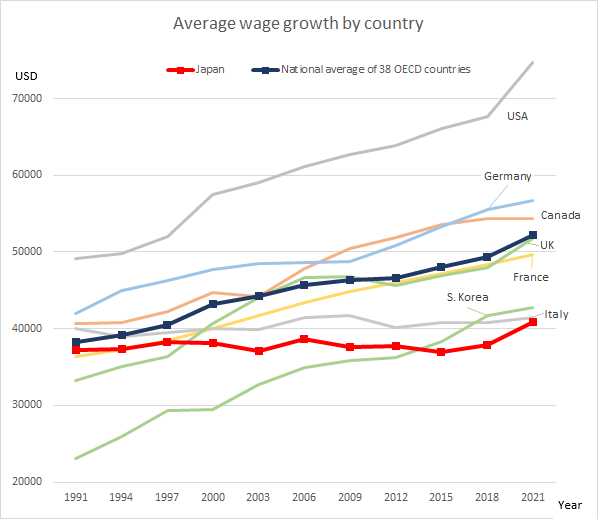
Source: OECD Data on Average wages
The other perspective is that of the employees who supply the labor. The decades after the bubble burst are known as ‘the lost 30 years’, and in this period of time, two new groups of workers entered the labor market, namely older people and women. The age at which people can start receiving their pension was gradually raised to 65. The Act on Stabilization of Employment of Elderly Persons requires industries to employ people up until this age. Older people who wish to keep working have remained in the labor market. In addition, the percentage of women in the workforce has been increasing since the 1970s. Older people and women are usually not regular employees; many are temporary or part time workers and thus tend to receive lower wages.
In summary, there are labor shortages in industries where it is difficult to raise wages, and a rising number of employees work without wage increases. In other words, Japan has an economic and demographic structure that makes it difficult to effectively pressure that wages be raised.
Wages aren’t increasing even though there is a shortage of essential workers in childcare, medical and nursing care sectors. How long will this situation continue?
Prof. Yugami:
Even if the costs of medical, nursing, welfare, childcare and other such services increase, this is often not reflected in the wages. Supervisory authorities have also provided guidance on raising labor remuneration.
There is a certain number of people (applicants) entering the job market for essential work regardless of these industries’ difficulties in raising wages. In the future, however, this supply of human resources will dry out. We will reach a so-called ‘turning point’ when applicant numbers plummet.
When a developing country goes through industrialization, there is a supply of low-cost workers coming from rural areas to the cities. This turning point theory is that when this supply of workers runs out, there will be a sudden increase in wages. This has happened during Japan’s growth in the past. The nursing care field has been experiencing labor shortages in recent years due to the continuing decline in the number of people who want to do this work despite the low pay. Sectors with labor shortages are trying to recruit foreign workers. However they will only want to come to Japan if efforts are made to improve workplace environments and working conditions.
Regular employees’ salaries are also stagnant
The salaries of regular employees in white-collar professions have also stagnated.
Prof. Yugami:
After the bubble burst, Japan has been unable to achieve expansive economic growth; there have also been periods of negative growth.
The economic climate is experiencing sudden changes, such as competition between domestic and foreign manufacturers, foreign capital entering the Japanese market, and Japanese companies relocating production overseas. These changes are leading to increasing uncertainty.
Behavioral economics involves analysing economic activity from a psychological angle. When we look at wages from this perspective, we can see that wage increases make people happy. However, when wages fall, people become unmotivated, and employee productivity declines. Employees dislike nominal wage decreases; therefore, it is difficult for companies to lower wages even when business is bad. This means that wages cannot fluctuate in accordance with the industry’s highs and lows. This is called ‘downward wage rigidity’.
During the period of high economic growth, there was a positive cycle whereby wages were increased, and then business performance would increase even more. But then the economy experienced negative growth, and since the build-up of uncertainty in the 1990s, a company’s performance no longer raises the wage standard (even when business is good) and profits are returned to the employees as a bonus or lump sum payment instead. Therefore, the wage standard for all regular employees no longer increases.
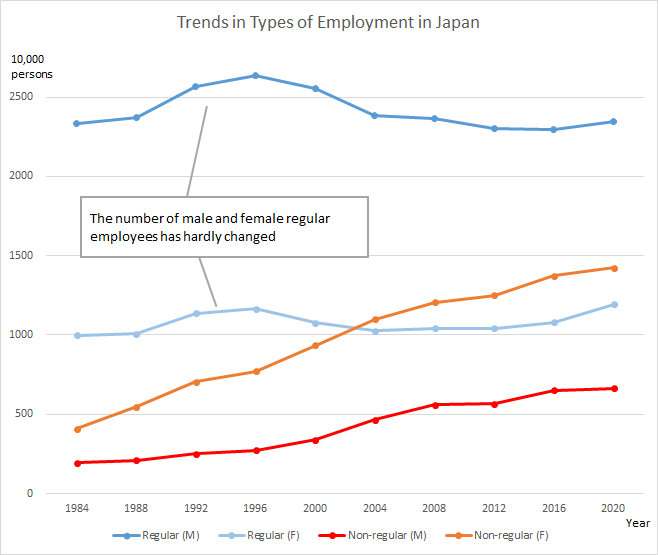
The negative effects of the so called ‘employment ice-age’, when companies were extremely reluctant to hire full-time employees, have been identified.
Prof. Yugami:
The number of regular employees has mostly stayed the same in the 30 years since the bubble burst. However, the total number of employed people has increased; with the majority of this increase being non-regular employees.
Non-regular employees are used as a buffer; their numbers are increased or decreased in response to economic uncertainty or changes in business performance. Regular employees are on a seniority-based wage system where their salaries go up with each successive year they work at the company, whereas non-regular employees’ salaries hardly increase even if they work for 10 or 20 years. They are constantly treated as if they were new employees. The overall average salary has declined because of the increase in non-regular workers.
It has also been observed that investment in employee training has declined since the 90s, even for regular employees. This was especially evident after the 2008 Lehman shock when training costs fell by half. Until the 1980s, companies were supported by bank loans and loyal stockholders through cross-holding. However, since the financial crisis in the 1990s, the primary method of financing has shifted from bank loans to direct finance (e.g., share issuance), and shareholders with foreign-investment funds etc. are seeking short-term business improvements. It is thought that training investment, which takes time to yield uncertain returns, has declined for this reason. The seniority-based wage system revolves around regular employees’ training, which increases their skills and raises their wages. With the decline in training investments, the tenure-wage profile of regular employees has flattened.
Unfortunately, there is no prospect of the wage standard increasing for the Japanese population due to the rising numbers of non-regular employees and the sluggishness of regular employees’ salary increases.
The changing shape of career development
What do you think the career paths of new graduates will look like in the future?
Prof. Yugami:
In other countries, it is rare for new graduates to become permanent employees as they have done in Japan. These young people are inexperienced employees; therefore, their aptitude is ascertained through a training period where they are an intern or a contract employee. They can then move on to a permanent position based on the evaluation of their experience.
In the future, even in Japan, not all new graduates will go straight into work, and there will be more than one career trajectory for young people. For example, some might decide to study abroad and then seek employment upon returning to Japan, or some might go on to graduate school.
Job-based employment is where people are hired based on the required skills that they possess. Therefore, if job-based employment increases in Japan, what people learn at university will be directly connected to their career and job-finding processes will become more diverse. In the future, it is thought that even companies will require post-graduate level knowledge, yet graduate student numbers in Japan are decreasing.
However, new graduates who can get a permanent position with training opportunities should take advantage of this opportunity. They can work out what they are good at; if they can achieve their goals at the company they can continue working there and if not, they can change jobs. However, even if the company really suits the individual worker, it may be merged with another company or declare bankruptcy. Therefore it is important for employees to always consider whether their skills are applicable to jobs at other companies.
From now on, people will have to work until they are 70 years old, so the content of their work will gradually change. It may be necessary for people to update their skills by getting public-funded retraining or obtaining scholarships to go to graduate school.
Recently, some top-ranking companies’ high salaries and high starting salaries have been much discussed in the news. Does this mean that the wage gap will get wider from now on?
Prof. Yugami:
There is indeed a movement to secure human resources in highly specialized occupations like IT engineering where what a person learned at university or graduate school is treated as proof of their cutting-edge skills, rather than the experience gained after entering a company. However, according to the latest research, this hasn’t led to a shake-up of Japan’s overall employment system, which is centered on the long-term development of human resources within a company.
Companies have their own pay scales and rules related to salaries; however, if an employee has high-level skills that cannot be developed in-house, then the pay rules may not apply to this individual. People already working in the company acknowledge that these supporting members are treated differently and that there are not many of them. I think that Japan’s employment practice of hiring new recruits and developing some of them into executives over time will continue.
Keeping growing disparity in check
There is a theory that advancements in AI (Artificial Intelligence) will lead to human job loss, with concerns that this will cause even greater disparity between people. Countermeasures have been debated in many countries, such as providing a basic income. What are your thoughts on this?
Prof. Yugami:
Why is increasing disparity such a problem? This is because inequality depends not only on individual ability but also on luck and chance, and this unequal access to opportunities causes inequality to be fixed in place. Furthermore, there are concerns that disparity will destabilize society because as it increases, so do the number of people who feel jealous and envious of those who are privileged. It is thought that if a society has a large middle class, then the number of people with extreme ideas or who make extreme judgements will decrease, allowing both governance and the economy to run smoothly.
In fact, the number of welfare recipients in Japan is increasing. The number of working-age recipients fluctuates according to the economic climate, however the number of elderly recipients continues to increase. Even though data shows little widening disparity after tax and social security redistribution, the problem is that the poverty rate (the percentage of people who receive less than half of the median income) is not decreasing. To counter this, Japan’s public assistance system strives to enable people to maintain the minimum standards of healthy, cultured living as stated in Article 25 of the constitution.
In countries around the world, different policies are being debated, such as negative income tax and tax credit for low-income working people. People who have a low income even though they work, are paid a certain percentage of their income as a ‘tax’ refund. Positive tax is normal tax where the earner pays a fixed percentage of their income to the government, negative income tax or negative tax is where the government gives the individual the fixed ‘tax’ percentage of their income. For example, a person earning a low annual salary of 1 million yen would receive 20% (200,000yen).
The public assistance system reduces the amount of welfare received by the individual based on their income, so even if the recipient works their total income does not increase. In contrast, with tax credit, people receive the fixed tax percentage of their income on top of their salary, so this means they are still incentivized to work. This kind of policy has been introduced in many countries including neighboring South Korea, the UK and the USA. The introduction of a tax credit system in Japan has been debated, however it has been put off because there is currently no system (for example, individual tax identification numbers) in place that can obtain an accurate understanding of an individual's annual income.
‘Basic Income’ would address the problem by giving each individual from childhood to adulthood fixed sums of money, and it is thought that this would simplify social welfare. I don’t think such a policy is necessarily aimed at reducing inequality as the idea is to replace existing tax redistribution and welfare systems. Additional tax resources would be required to set up a basic income system or a negative income tax system. I think that in-depth debate on such ideas is currently not progressing due to tax resource issues and the problem of how to integrate these new measures into existing social security systems.





